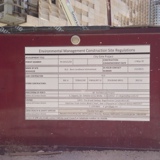Title Page
-
Site conducted
-
Conducted on
-
Prepared by
-
Location
Environmental Audit (Draft)
-
-
ENVIRONMENTAL AUDIT
-
Table 1. Section 1 - Pollution prevention and response - standards and auditing results
-
Reference
-
Standard
-
Auditing results
-
Section 1 - Pollution Prevention Planning
-
Have you consulted with the project environmental advisor / manager (if one has been appointed)?
-
Have you reviewed your Environmental Management System (EMS) if you have one?
-
Are you diverting water on site? If yes, have you received permission from the Environment Agency to do so?
-
Have you identified:
-
the potential pollutants?
-
the potential to cause pollution on site?
-
any historical contamination? If so, where is risk management documented?
-
control measures to prevent pollution?
-
Are pollution prevention methods recorded? If so, where?
-
Have pollution prevention requirements been communicated to those working on site?
-
Have you identified pollution prevention communication & awareness sessions for those working on site, e.g. Tool Box Talks?
-
Have you identified drainage on site?
-
Has drainage been colour coded?
-
Have you identified all surface water and groundwater on, under and around the site?
-
Have you contacted local regulators?
-
Have you invited them to visit the site if appropriate?
-
Have pollution incidents been planned for and do you have an incident plan?
-
Have you nominated a ‘responsible person’ for pollution prevention on site?
-
Have site personnel been trained to use spill kits?
-
Have you considered how to minimise and manage your waste on site?
-
Have you identified local weather conditions and the means to keep updated throughout the project?
-
Have you developed a site inspection routine to check for pollution incidents or potential problems?
-
1:2 Vehicles and Deliveries
-
Is a Traffic Management Plan in place?
-
Has a location for deliveries (the delivery point) been identified?
-
Is the delivery point located away from watercourses, drains and hazards?
-
Have times for deliveries been identified to avoid disruption to operations or neighbours?
-
Have suppliers and staff been informed of the delivery point and delivery times?
-
Has a designated ‘responsible person’ been identified to supervise deliveries?
-
Has the condition of drums, containers or tanks been inspected and verified fit for purpose before accepting the delivery?
-
Are emergency response plans and spill kits located at delivery points?
-
Have you planned how you will prevent mud being taken off site by delivery vehicles?
-
1:3 Materials Storage, Stockpiles and Exposed Ground
-
Are stockpiles located to minimise the risk of pollution?
-
Are appropriate methods in place to safeguard the condition, structure and quality of top and sub soils during stripping, handling, storage and reinstatement
-
Are they away from watercourse, ditches or drains?
-
Are stockpiles protected or damped down to reduce dust?
-
Are stockpiles covered and/or protected to reduce or intercept silt runoff?
-
Are contaminated stockpiles located in an appropriate area?
-
Are there arrangements for containing packaging waste?
-
1:4 Oil Storage, Use and Refuelling
-
Is there documentation to demonstrate compliance with legal requirements for oil storage, use and refuelling
-
Are oil storage areas away from high risk areas?
-
Are oil storage areas on an impermeable surface?
-
Are tanks, drums or containers in good condition with no sign of damage or corrosion?
-
Have oil stores and containers for secondary containment?
-
Is secondary containment sufficient to contain contents of the containers?
-
Are bunds/drip trays being kept up to date for oil and rainwater leaks?
-
Are oil store maintenance and inspection records being kept up to date?
-
Is refuelling equipment stored within secondary containment when not in use?
-
Are oil storage containers and stores secure e.g. kept lock shut when not in use?
-
Are emergency plans and spill equipment available at oil storage areas?
-
Are emergency plans and spill equipment available at refueling areas?
-
Have staff been trained in the use of spill kits and in emergency procedures?
-
Has a responsible person been designated to oversee implementation of the emergency plan?
-
1:5 Cement, Concrete and Grout – NA
-
Have control measures been put in place to prevent cement, grout or concrete wash-off entering watercourses or drains?
-
Are staff aware that they shouldn’t let cement, grout or concrete washings enter surface waters or surface water drains?
-
Are designated wash-off areas provided?
-
Are wash areas contained and sited away from surface waters and surface water drains?
-
Has the treatment and disposal of wash-off effluent been considered?
-
Is cement powder stored carefully on site to prevent leaks and dust?
-
Have you considered the products ordered, quantities and timing?
-
1:6 Chemicals and Hazardous Substances – NA
-
Do you only order and store the quantities you need?
-
Are chemicals and hazardous substances stored in bunded areas away from watercourses and drains?
-
Are storage facilities located to avoid damage from site traffic or vandalism?
-
Are the storage facilities locked when not in use?
-
Are all chemicals and hazardous substances clearly labelled?
-
Is a spill kit or emergency response equipment kept at the storage point?
-
Have you produced an emergency plan for the site?
-
Are all staff trained in how to deal with chemicals or hazardous substances they use as part of their job? Do they know how to prevent pollution in an emergency?
-
Are the Safety Data Sheets provided by the supplier stored with the emergency plans?
-
1:7 Excavations
-
Has the site been investigated for contamination?
-
If there is contaminated soil, do you have procedures in place to manage it?
-
Have you checked with the Environment Agency if you need permission for extraction, dewatering or discharge?
-
Do you have any necessary permissions in place before you start work?
-
Have you taken measures to prevent water entering excavations?
-
Have the staff working on excavations been made aware of risks and control measures?
-
Have you identified all watercourses culverts and drains on or close to the site?
-
Have you got vegetation corridors alongside the watercourse or drain to act as a buffer to help prevent silt entering them?
-
Have you the necessary permissions if you plan to dispose of water to a drain or watercourse?
-
1:8 Site Environment Plan
-
Has The Principal Contractor Site Environment Plan been completed/being updated regularly, as required?
-
Section 2: Nuisance Emissions
-
Table 2. Nuisance Emissions
-
Reference
-
Standard
-
Auditing results
Section 2 - General Good Practice
-
Have you identified potential nuisances before starting work?
-
Have you put in place a control measure to minimise each nuisance that you’ve identified?
-
Have you found out and complied with any restrictions such as working hours and noise levels?
-
Have you a procedure for dealing with complaints from neighbours?
-
Has the scope of work been communicated to neighbours?
-
Have you made site workers and sub-contractors aware of nuisance restrictions?
-
Is nuisance monitoring required? If so, do you have monitoring equipment and a programme in place?
-
If your monitoring shows you have a problem, put it right!
2:2 Site Environment Plan
-
Has the The Principal Contractor Site Environment Plan been completed/being updated regularly, as required?
-
Section 3: Emissions to water
-
Table 3. Section 3 : Emissions to Water
-
Reference
-
Standard
-
Auditing results
3:1 Silty Water
-
Can you avoid exposing areas of bare ground until you need them?
-
Have you got vegetation corridors along any watercourse or drain to act as a buffer to help prevent silt entering them?
-
Have you identified all the potential sources of silty water on site?
-
Have you the necessary permissions in place if you plan to dispose of water to a drain or watercourse?
-
Are silt controls in place to prevent silt entering watercourses or drains?
-
Have you installed cut-off trenches or other features to minimise the amount of run-off on site?
-
Are you required or have you considered using SuDS?
-
Do you have an inspection and maintenance programme for all your silt treatment systems?
-
Are plant, wheel and boot washing facilities sited at least 10 metres away from surface waters?
3:2 Drainage
-
Have all drains on site been located, and identified as either surface water or foul?
-
Have drains been checked for existing protection?
-
Have pollution risks to the drains been identified?
-
If anything will be discharged to drains, have you applied for a permission?
-
Have plans been put in place to prevent pollution entering watercourses in emergencies?
-
Are spill kits located near drains?
-
Are you required to use or have you considered using SUDS?
-
Have silt traps and oil separators been identified / installed?
-
Has an inspection & maintenance schedule for drains and protections measures been established?
3:2 Site Environment Plan
-
Has the The Principal Contractor Site Environment Plan been completed/being updated regularly, as required?
-
Section 4: Ecology
-
Table 4. Section 4: Ecology
-
Reference
-
Standard
-
Auditing results
4:1 General Good Practice
-
Have all ecological surveys been completed and reports issued?
-
Have all necessary method statements/mitigation strategies been produced and approved by the appropriate regulator?
-
Have all ecological licences been issued?
-
Do the construction phasing plans take into account seasonal ecological constraints?
-
Are there detailed drawings/descriptions covering any habitat creation/planting etc proposals?
-
Has a project ecologist been appointed (by The Principal Contractor or the Client) if necessary?
-
Have all the pre-construction mitigation measures been completed?
-
Has an ecological toolbox talk been provided to site staff?
-
Is there an ecological checklist available to all staff (e.g. in the canteen)?
-
Is the site fencing intact and in good condition?
-
Is there a provision for a daily check of the reptile fencing?
-
Are there plans for regular site checks from the project ecologist?
-
Are there procedures to check the (legally) agreed ecological method statement and programme against the evolving construction timetable, including when/how to extend/modify any licences?
-
Are there good communication methods to inform the project ecologist of any changes in construction methods or timing?
4:2 Site Ecological Method Statements/Mitigation Strategies
-
Have the site-specific ecological method statements/mitigation strategies been implemented? / being updated regularly, as required?
-
Have protected species (e.g. water vole,) been excluded from the working area in accordance with agreed mitigation strategies, planning conditions and Natural England licences?
-
Have all habitat creation measures been implemented at the correct time?
-
Have all replacement habitats been erected?
-
Has all habitat creation been undertaken in accordance with the plans?
-
Is a mechanism in place to hand over management of newly created habitats to WWT/land owner (including any modifications to the required management)?
4:2 Site Environment Plan
-
Has The Principal Contractor Site Environment Plan been completed/being updated regularly, as required?
-
Section 5: Landscape & Trees
-
Table 5. Section 5 : Landscape & Trees
-
Reference
-
Standard
-
Auditing results
5:1 Landscape
-
Have all landscape surveys been completed and reports issued?
-
Are there any sensitive or protective landscape issues/designations and if so, have these been dealt with through relevant permissions/agreements?
-
Have all necessary landscape designs, planting schedules/method statements/been produced and approved by the appropriate regulator?
-
Has the role of landscape contractor been appointed?
-
Do the construction phasing plans take into account seasonal landscaping constraints?
-
Are there detailed drawings/descriptions covering any landscape/habitat creation/planting etc proposals?
-
Have all the pre-construction mitigation measures been completed?
-
Has a toolbox talk been provided to relevant site staff?
-
Is the site demarcation fencing intact and in good condition?
-
Is there a provision for a daily check of the fencing?
-
Are there procedures to check the agreed landscape method statement and programme against the evolving construction timetable, including when/how to extend/modify any restoration proposals?
-
Are there good communication methods to inform the landscape contractor of any changes in construction methods or timing?
-
Has the site landscape been restored/re-planted in accordance with the detailed landscape designs associated with the planning permission?
-
Is a mechanism in place to hand over management of newly created landscapes to WWT/landowners (including any modifications to the required management)?
5:2 Arboriculture
-
Have the site-specific arboricultural method statements/tree protection plans been implemented?
-
Have Root Protection Zones for retained trees been marked out? If not, why not?
-
Has tree protection fencing been installed (if appropriate)?
-
Have the trees associated with the site been left/managed in accordance with the detailed arboricultural proposals associated with the planning permission?
-
Has all tree surgery required as part of the construction activity been completed?
-
Has all tree planting (as part of the landscape design) been completed?
-
Is a mechanism in place to hand over management of trees back to WWT/Landowner (including any modifications to the required management)?
5:2 Site Environment Plan
-
Has the Principal Contractor Site Environment Plan been completed/being updated regularly, as required?
-
Section 6: Land Contamination and Invasive Species
-
Table 6. Section 6 : Land Quality and Invasive Species
-
Reference
-
Standard
-
Auditing results
6:1 General Good Practice
-
Have you investigated the site history to check for potential land contamination?
-
Have areas of land contamination or invasive plants been identified before starting work?
-
Are all areas of land contamination and/or invasive species marked on site drawings?
-
If there are contaminants, have you contacted the Environment Agency to discuss how you will deal with them?
-
If there are invasive plants on site, are you confident you can manage them effectively and comply with your duty of care?
-
If you plan to treat invasive plants in or near water with herbicides, have you contacted the Environment Agency for permission?
-
Is it necessary to gain expert advice to deal with any land contamination?
-
Is there a remediation strategy for dealing with any contamination?
-
Are control measures in place to ensure contaminants or invasive plants are not spread within or outside the site?
-
Are staff aware of how to recognise land contamination, and what to do if they find any?
-
Are staff aware of how to recognise invasive plants, and what to do if they find any?
-
Have you planned for stockpiling contaminated materials carefully to prevent spread of pollution? e.g. more than 10 metres away from watercourses, on impermeable surface, bunded and covered
-
If contaminated soil needs to be removed from site or treated on site it may be considered waste
6:2 Site Waste Management Plan
-
Has the The Principal Contractor Site Waste Management Plan been completed/being updated regularly, as required?
6:3 Site Environment Plan
-
Has the The Principal Contractor Site Environment Plan been completed/being updated regularly, as required?
-
Section 7: Waste
-
Table 7 Section 7: Waste
-
Reference
-
Standard
-
Auditing results
7:1 General Good Practice
-
Do you have copies of all waste carriers’ registration certificates?
-
Are waste carriers’ registrations in date?
-
Have you identified your most common European Waste Catalogue (EWC) codes / List of Waste Codes (in England and Wales) to help people on site complete waste transfer notes and consignment notes correctly?
-
Do you have a system for keeping waste transfer notes and consignment notes?
-
Have you made plans to secure all waste in vehicles leaving site and skips are covered where appropriate?
-
Is waste contained securely and safely on site to prevent escape?
-
Are waste containers (skips, bins) impermeable to prevent liquid wastes leaching?
-
Have you allocated sufficient space on site for waste storage and segregation?
-
Are skips and bins on site labelled for different waste types to help segregation, and checked regularly?
7:2 Site Waste Management Plan
-
Has the Principal Contractor ’s Site Waste Management Plan been completed/being updated regularly, as required?













